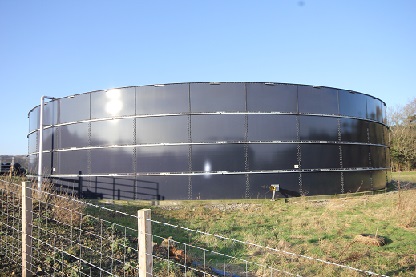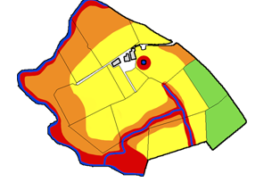Winter slurry storage and contingency planning
Download a PDF version of this page
Making best use of nutrients in slurry should be every landowners goal. Forward planning is essential to manage slurry in a safe and responsible manner and to avoid unnecessary pollution incidents, whilst also getting the best out of the nutrient value.
The aim is to store slurry produced around the steading for spreading on fields at a time when the nutrients can be utilised by the growing crop; SEPA recommend a minimum of 22 weeks of storage for cattle slurry to take you over the winter period. By knowing nutrient value in slurry and applying at the right time, you can ‘top up’ nutrient requirements for the growing crop from bought in fertiliser. Based on soil testing, knowing the nutrient value in slurry and matching it to crop demand, you can improve nutrient use efficiency, benefit the environment and save money.

To maximise the available space for slurry storage, any additional sources of ‘clean’ water around the steading should be prevented from mixing with contaminated areas. An inch of rain on an acre of ground (4,840 sq yds) equates to 27,154 gallons, so it’s worth taking a second look at large areas of concrete; if yards are clean, runoff does not need to be collected and added to the slurry store. Carrying out a 4 Point Plan steading dirty water audit can help you identify and minimise these additional sources going into your store.
With your average dairy cow able to generate around 18 to 20 litres of product per day destined for the slurry store, you could easily be looking at around 2,000 litres per day from a 100 cow herd. With potentially 14,000 litres per week of slurry to deal with, this could be the equivalent of seven tanker loads; this is before any other liquids are pumped into the tower or lagoon. Remember not all of your tower or lagoon is capacity is available for storage; a gap or freeboard from the top of the tank must be maintained. This is 300mm in a slurry tower and 750mm in a lagoon. With prolonged spells of heavy rain, this freeboard can suddenly disappear, leaving you with an overtopping tower or brimming lagoon.
Storage capacity becomes even more important to farmers within Nitrate Vulnerable Zones due to closed periods where no slurry can be applied. Depending on your location, soil type and target crop, closed periods could start as early as 1st August and run to 31st January, so it’s worth knowing which closed periods apply to you.
Every farm with livestock should have a RAMS (Risk Assessment for Manure and Slurry) plan. This will demonstrate the no spread, high, medium and low risk spread areas on your farm. No spread areas include a minimum distance of 10m from a watercourse; this should be increased if land is sloping in the direction of the burn and could therefore aid runoff.
Ready to find out more about how to create a RAMS map?
Visit the Farming & Water Scotland website.
Slurry shouldn’t be viewed as a waste; if managed correctly it has a real nutrient value. A 10m3 tanker of dairy slurry have an equivalent worth of around £30 to £50 of bought in fertiliser, depending on quality, method and timing of application. The best time for application is when soils warm up again in March onward, so in nutrient terms, winter spreading becomes no more than a waste disposal operation, can cause damage to fields through trafficking and is a loss of nutrients, and value, to the farm business.
Minimising excess water going into the tower is a priority; here are some ideas to adapt or consider for your farm:
- Take a second look at concrete aprons etc on the farm; which areas can be kept ‘clean’ and therefore don’t need to be collected? Keeping clean and dirty areas separate could minimise the amount of dirty water that needs to be collected.
- Do all roofs around the steading have functional gutters and downpipes? Clean rainwater should be collected and reused or routed to a clean drainage system, not add to the volume collected from dirty yards.
- Rainwater should be kept out of reception pits and slatted areas; this might be as straight forward as creating a raised concrete bund to divert rainwater.
- Parlour washings and collected yard slurries should be directed to the slurry tower or holding tank; could you change to a high pressure hose rather than a standard or volume washer for washing down, reducing the amount of water you need to deal with?
If you are struggling for space and need to put emergency measures in place:
- Do you know the capacity of your tank and daily slurry volume going into the tower? How many days storage do you have left? Remember you should ideally be maintaining a freeboard too.
- Do you know the volume of your reception pit? This may have a two/three day capacity which may allow in severe conditions the opportunity to offload slurry to an area safe for spreading.
- Do neighbours have capacity to temporarily take some of your slurry, to ease pressures on existing stores?
- Have you an up to date a RAMS plan to identify the low risk spreading areas on your farm? Note slurry should not be applied on waterlogged, frozen or snow-covered ground.
- If you are forced to spread outside the growing season, do so in line with your RAMS plan and do not exceed 20 m3/ha. The aim here is to alleviate storage space for a couple of weeks, not to empty your store at a time when nutrients will be simply lost to the environment.
If conditions don’t allow field access and you think you are going to exceed storage capacity, it’s worth discussing options with your local SEPA office.
In the event of an overflow or spill:
- Can you contain as much of the spill as possible? Do you have bales at hand to block the flow of slurry, or the option to dig an emergency trench to intercept slurry and prevent it reaching the water environment?
- Do you know where all your clean water drains are, so as drains can be covered and pollution avoided?
- Can you dam and pump the slurry to a safer location?
If you have a slurry spill, don’t run the risk of being reported, get in touch with SEPA straight away.
SEPA manage a 24hr pollution hotline 0800 80 70 60.
Playing safe is better than being be responsible for a pollution incident.
For more information:
- Details on how to complete a RAMS land plan is contained in the 4 Point Plan at Farming and Water Scotland here.
- The 4 Point Plan contains a steading audit checklist to identify opportunities around the steading to minimise dirty water – available via Farming and Water Scotland at farmingandwaterScotland.org
- Farming and Water Scotland offer a farmer friendly guide to the regulations every farmer should adhere to in the Know the Rules
- Information on slurry storage in lagoons on the FAS pages here
- Previous position statements from SEPA during periods of wet weather sepa.org.uk/regulations/land/agriculture/agricultural-spreading-of-slurry/
- Maps and scheme guidance for Nitrate Vulnerable Zones (NVZs) is at gov.scot/policies/agriculture-and-the-environment/nvz/
Sign up to the FAS newsletter
Receive updates on news, events and publications from Scotland’s Farm Advisory Service


